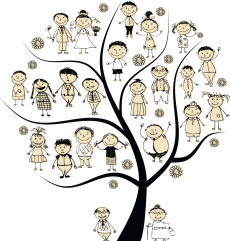
Many aristocratic families, who live in big manor houses, have portraits of ancestors hanging from the wall that go back hundreds of years. They can see if there is a “family nose”, chin or other feature that recurs in every generation. Most of us can’t do that, and have no idea of the names of the people whose DNA we carry inside us, and whose physical traits and mannerisms we may share. It is pretty easy now to trace your family tree online, although it can be costly, like any other hobby. But if you listen well, you’ll find there are ways to keep the cost down.
The first thing you need to do is question all your relatives, parents, grandparents, uncles, aunts and cousins of all ages about everything they know about their family. They may even show you any old documents like old photographs, marriage certificates, birth or death certificates or anything else relevant. Make copies of all of this. Write down all you are told. However, take names, places and dates with a pinch of salt as it is easy for the person remembering to get confused.
When you have completed your data gathering, it’s time to start doing the research properly. Hopefully you have the name of someone born before 1901, or at least before 1911. These were the first censuses taken in the 20th century, and the most recent ones we can access. If not, the only way to start is to apply for either the earliest marriage certificate you can or the earliest birth certificate. If it’s a birth certificate in England and Wales, it will show the mothers name including her maiden name, the father’s name, and their address at the time of the birth. In Scotland, more information is shown, such as the date and place of the parents’ marriage.
On a marriage certificate, an indication of a person’s age will be given, even if it only says “of full age”. This means over 21. The names and occupations of the fathers of both the bride and groom are also shown. So, it is possible to trace back your family. You start at birth, then their parents’ marriage, their parents’ birth, and so on. Do this until the start of civil (legal) registration, which was 1837 in England and Wales and 1855 in Scotland. But if you manage to find someone who as above was born on or before 1911, you can start looking at the census.
These were done every 10 years in England and are the most useful tool for tracing your family history is 1841 onwards. Due to confidentiality rules, they are closed for 100 years, so the most recent we are able to access is the previously mentioned 1911 census. Search for your relative in the nearest census to the date you have, but be careful that your facts tie up, especially if they have a common surname.
Always record where you found the entry, so you can go back to it later. This is a useful life tool you can use for writing essays in the future! There is a large choice of family history software to record findings even photographs; a really good free one is called Legacy Family Tree. There’s also Ancestry, which you have to pay for. However, many libraries have access to Ancestry.com, which is a way of doing research that costs very little. Unfortunately, copies of birth and marriage certificates from the local councils are expensive. If you want to find out more, search the web, for there’s plenty more information to be found about the past on there.
Image from: http://www.johngraycentre.org/learning/projects/past-projects/family-history-day-share-your-memories/

0 Comment:
Be the first one to comment on this article.